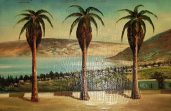The Jews of Spain
A History of the Sephardic Experience
By
Jane S. Gerber
“As apparent to these observers and indeed all visitors, a brilliant era was dawning in Spain. Forever afterward, the tenth and eleventh centuries would be remembered by Jews as the nation’s ‘Golden Age,’ an epoch in which they enjoyed unusual political power and could participate actively in the dominate culture. No less cherished in Islamic memory, the period gave rise to the legend that when Allah was creating the world, Andalusia asked for five things: clear skies, a sea well stocked with all manner of fish, trees laden with every species of fruit, beautiful women, and a just government. Allah agreed to everyone one of these request but the last, having decided it all were granted Andalusia would rival Paradise.” (pg.28)Spain did not recognize the State of Israel until January of 1986. In May of 1978, Spain finally abolished a state religion and established the concept of freedom of worship. After Vatican II, in December of 1968, Spain revoked the edict of expulsion, which had been put in place in 1492. (pgs. 264-265)
The Jews of Spain, A History of the Sephardic Experience by Jane S. Gerber, The Free Press, a Division of Macmillan, Inc., New York, New York, 1992, is one of the most fascinating books I have ever read. I mentioned I was reading this book to Fran, a retired librarian, with impeccable taste; she instantly asked to borrow it when I was done. I was of course thrilled to share the book, but horrified that I had written, to such an extent, on its pages. Ms. Gerber has offered the choicest morsels, setting down a banquet of knowledge which instantly draws the reader into a journey through hundreds of years of history.
The book is incredibly well researched and documented, while being quite readable. Ms. Gerber introduces her book with the “Enigma of 1492”. The Jews were expelled from Spain, on the same day, that Christopher Columbus was given permission to sail, to what would be the New World. In 1492, the New World was to be discovered by the Old World, and Sephardic Jews, who had been in Iberia for 1,500 years, were sent into forced exile, closing a remarkable chapter of their history, while being forced to begin anew, once again.
The story of the Sephardic Jews begins with the Roman diaspora (200 BCE-200 CE) which permitted the Jews to freely move within the Roman world, including Iberia; the Romans were tolerant of the Jews religious and cultural practices, as well as allowing them to self-govern, with Rome recognizing the economic benefit which the Jewish population provided. Tolerance ends in the fifth century under Emperor Constantine, when he declares the Roman Empire to be Christian, and conversion to Judaism suddenly caries a death sentence.
The Romans are overrun by the Germanic tribes, who once again practice a sort of tolerance towards the Jews, acknowledging the stability and productivity which they provide, to the area as a whole; until conversion to Catholicism is seen as a uniting political factor, as is persecution of the Jews. We also see the foundations laid for the lack of proselytizing within the modern day Jewish community. In attempting to limit Jewish influence over Christians, the Visigoth King Reccard I converted to Catholicism and declared Jews could no longer own slaves, and must turn their slaves over to Christians, thereby eliminating the Jews from agricultural enterprises, the Jews were not allowed to intermarry, hold public office, and any Jew who proselytized was executed. By 613, the Jews were subjugated to force conversions, with those who refused baptism facing one hundred lashes, confiscation of property, and banishment. The Visigoths hatred went so far as to demand “that all business transactions between Jews and Christians begin with the Lord’s Prayer and consumption of a dish of pork.” (pg. 15)
In 711, the Arab conquest of Iberia begins, and the Visigoths are rather easily defeated. In many cases, the advancing Berbers and Arabs would be met by abandoned cities, where the Christians had fled, and the persecuted Jews remained behind, and were thus put in charge of the cities, by the Arabs. The Islamic Arabs offered conquered non-monotheist the choice of conversion or death. Monotheistic Jews and Christians, however, were viewed as a tolerated minority, that was not forced to convert. Though it should be noted that the level of leniency, acceptance, and privilege varied between leaders, countries, and time periods – Iberia was one of the best places for Jews to be, under Arab rule.
We enter the Pax Islamica, and a Golden Age for the Sephardic Jew where “travel for the sake of knowledge” is a “venerable and pious activity.” Art and architecture explode in Iberia, as a general thirst for knowledge leads to a massive library and the translation of Greek text into Arabic, by Jewish linguist. Law, science, medicine, astronomy, mathematics, music, and poetry are devoured by a famished community seeking enlightenment. The first private library is created by Samuel ibn Nagrela, born in 933, in Cordoba, a brilliant Jewish man who captures the Sephardic love of books, knowledge, and education. (pg. 53)
Ms. Gerber beautifully takes us through the Sephardic journey, as the Catholic Monarchs, Ferdinand and Isabella Reconquista Iberia, creating Spain, and expels the Jews, who are forced to escape what has been their home for a thousand years. They are welcomed in few places; but the Ottomans do open a door, which will allow the Sephardic’s to set up the Balkan Jerusalem; ushering in a period of growth and production, powered by the printing press which they had mastered in Spain. (pg. 153) This was a remarkable read, a true delight in every way – well, except for the horror of what one people can inflict upon another.
My father was born in Cuba, but his people came from Andalusia, where the Sephardic Golden Age occurs. I remember him speaking of the family ties to Andalusia and Morocco, and as I dove further and further into Ms. Gerber’s book, I marveled at how she spoke to my soul. The paradox of the man “Whose life is Spain and whose destination is Jerusalem.” (pg. 61)
This book is overflowing with bits of information that were new to me, like the tale of the ancient Khazar Kingdom, which persecuted by the Byzantine Christians and Islamic warriors, demanding that the kingdom convert, chooses to become Jewish.
The author tells the Sephardic story through the end of the twenty century, including the impact of the Greek revolt against the Turks, the general decline of the Ottoman Empire, the Zionist Movement, the First and Second World Wars, the rebirth of Israel, and the Sephardic in present day Israel.
Unequivocally, this is one of the finest books that I have ever read, and whole heartedly recommend it to anyone interested in the Sephardic experience, Spain, Israel, history, or simply life.











